How Much Does It Cost to Build a SaaS Platform?
- Updated: Aug 27, 2024
- 10 min
Are you a startup founder, product leader, or serial entrepreneur wondering what it costs to build a SaaS platform?
If so, keep reading to learn:
- How much it costs to develop SaaS software
- Factors that influence SaaS dev costs
- Hidden expenses of building a SaaS
- Case studies on real SaaS platform costs
If you’re deciding between software models, this comparison of the ASP model vs SaaS model can help you choose.
Now that you know what we’ll cover, let’s kick things off by looking at the SaaS development cost.
If you prefer visuals over text, feel free to jump ahead to the bonus infographic.
Unlock your SaaS potential now — start transforming your vision into a scalable solution with our expert developers today!
What Does It Cost to Build a SaaS App?
The cost of developing a minimum viable product for a Software-as-a-Service startup should typically range from $60,000 to $150,000.
However, other factors determine the exact cost, among which include:
- The complexity of the solution
- The type of product
- The type of team involved
- The location of the developmental team
Let’s consider each of them separately for deep insight into their intricacies.
SaaS Development Costs Based on Complexity
SaaS platform complexity is a term to describe the set of functionalities, user roles, and how they relate to each other in your application.
You can also describe them as the level of difficulty a developer faces while building the SaaS.
While the term “complexity” is quite relative, we can categorize them into micro, basic, average, and complex for better understanding.
As you might have imagined, the more the complexity of a SaaS app, the more time needed to be expended in its development; this will, in turn, affect its cost.
Let’s help you with a spreadsheet of the estimated cost implication based on complexity:
| Complexity | Average price, $ |
| Micro SaaS | 15,000 |
| Basic SaaS | 15,000-50,000 |
| Average SaaS | 60,000 |
| Complex SaaS | 100,000-500,000+ |
The price stated above is not definite, as some hidden costs might pop up along with the cause of development. E.g., the cost of purchasing a domain name, integrating with APIs, etc. 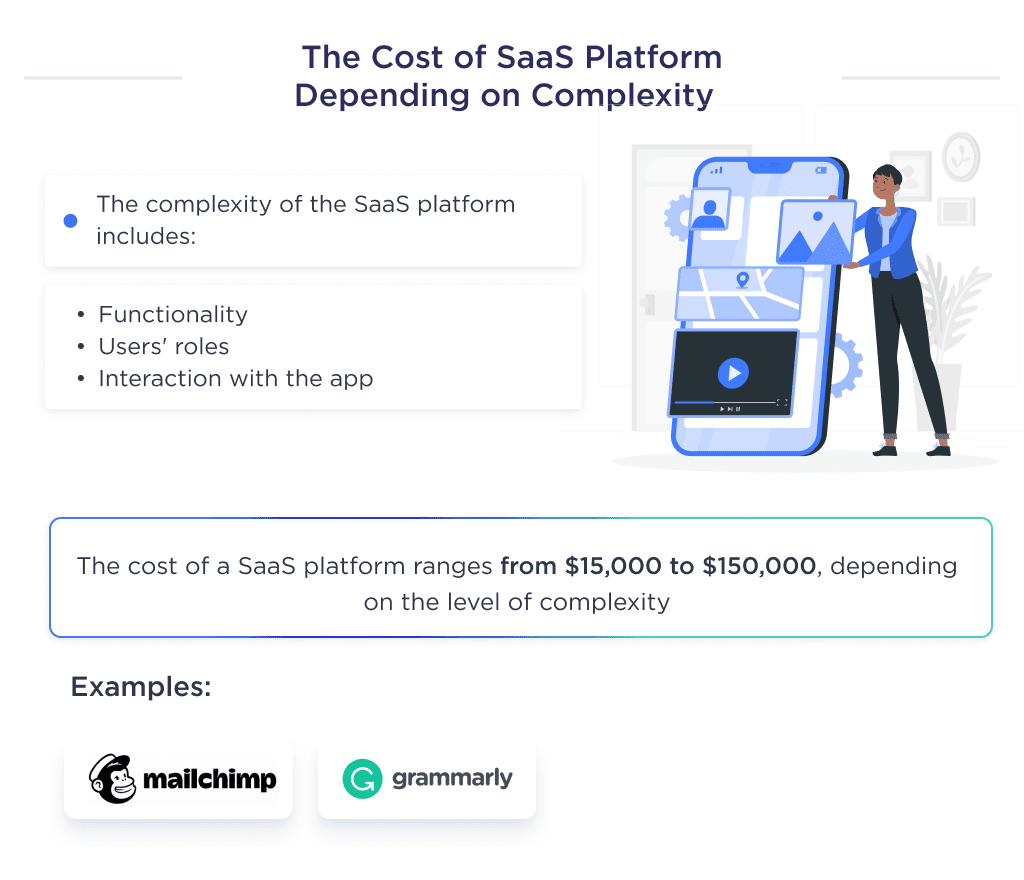
Another defining cost factor is the product type. Let’s dive into detail.
SaaS App Development Costs Based on SaaS Type
Another important factor that influences the cost of building a SaaS app is the type of software.
Some SaaS projects are very difficult to build, mainly because they should have a high level of new features and the sensitivity of the data being handled.
Take, for example, accounting software.
It requires state-of-the-art data protection technologies to prevent sensitive financial information from leaking.
This singular feature increases the price of the site:
| Type of SaaS | The average cost for an MVP, $ | Example |
| CRM | 60,000 | Freshworks |
| ERP | 120,000 | NetSuite |
| Accounting | 80,000 | Xero and Quickbooks |
| Project management | 70,000 | Confluence |
| Email marketing | 70,000 | Mailchimp |
| MarTech | 100,000 | Hubspot |
| Visual website builder | 150,000 | Weblium |
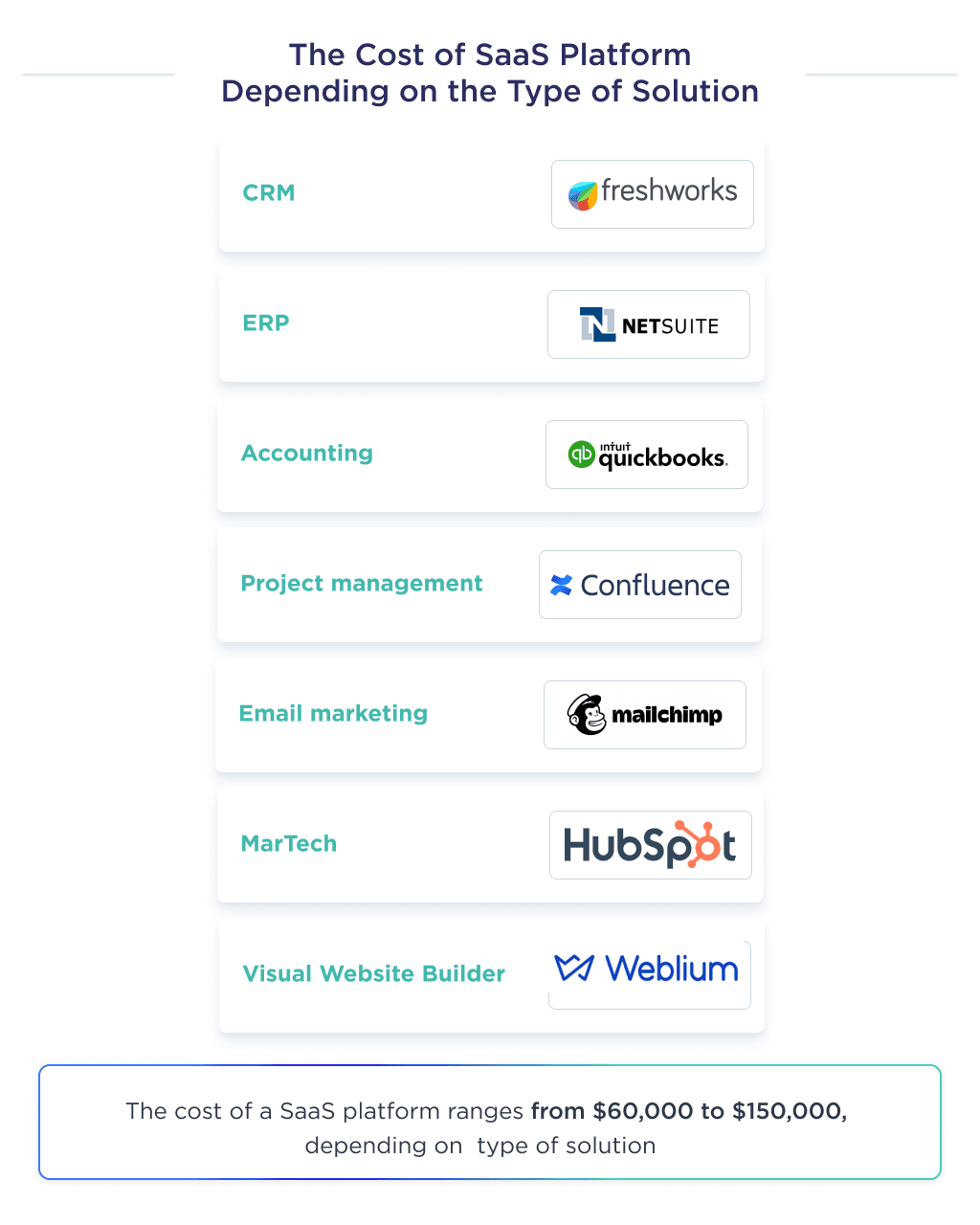
SaaS Software Development Costs Based on Team Type
Let’s dissect how the type of development team you opt for may affect the SaaS app development cost.
To illustrate, we’ll assume you’re building a software-as-a-service platform with average complexity.
| Type of Team | Average cost, $ |
| In-house, the US | 140,000 |
| The local development company, the US | 180,000 |
| Freelance | 50,000 |
| Outsource agency | 80,000 |
Does each kind of team in the spreadsheet seem confusing? Let’s help you have a better understanding of what they entail.
Looking for inspiration? Here are the best SaaS startup ideas making waves in the market.
Explore our SaaS services today
Type 1. In-House Team
This hiring model entails employing a team of developers to work within your startup’s environment.
These developers take orders directly from the company’s administrators and report daily to superiors within your startup.
Before you decide on choosing this option or not, you should first educate yourself on its pros and cons:
| Pros | Cons |
|
|
Making the right choice is crucial. Here’s everything you need to know about in-house development vs. outsourcing.
An alternative to this option is hiring a local development company. Let’s discuss the nitty-gritty of this.
Type 2. Local Development Company
This option can be pricey for startups domiciled in the UK, USA, Canada, and other high-income nations.
We’ll consider its pros and cons to understand your options better.
| Pros | Cons |
|
|
The cons of hiring a local development team are too significant for most startups to bear. As such, we’ll discuss another alternative – hiring freelancers.
Type 3. Freelancers
Freelancers are independent SaaS developers with experience in several tech stacks requisite for developing a fully functional Software-as-a-Service platform.
These individuals are not committed to working for any organization but only focus on getting contracts from numerous clients and executing them as occasion demands.
Just like other options on this list, they also have their pros and cons to consider.
| Pros | Cons |
|
|
The last and arguably the best option to consider is an outsourced team. What does this entail?
Type 4. Outsourced Team
Opting for an offshore outsourced team is a trendy pattern for startups based in high-income nations.
The crux of this model centers around seeking a SaaS development team in a nation different from the startup’s country of residence.
For example, a US-based startup hired a software development agency domiciled in Ukraine to help build a SaaS solution.
This option offers lots of advantages, with only a few cons that can be worked around:
| Pros | Cons |
|
|
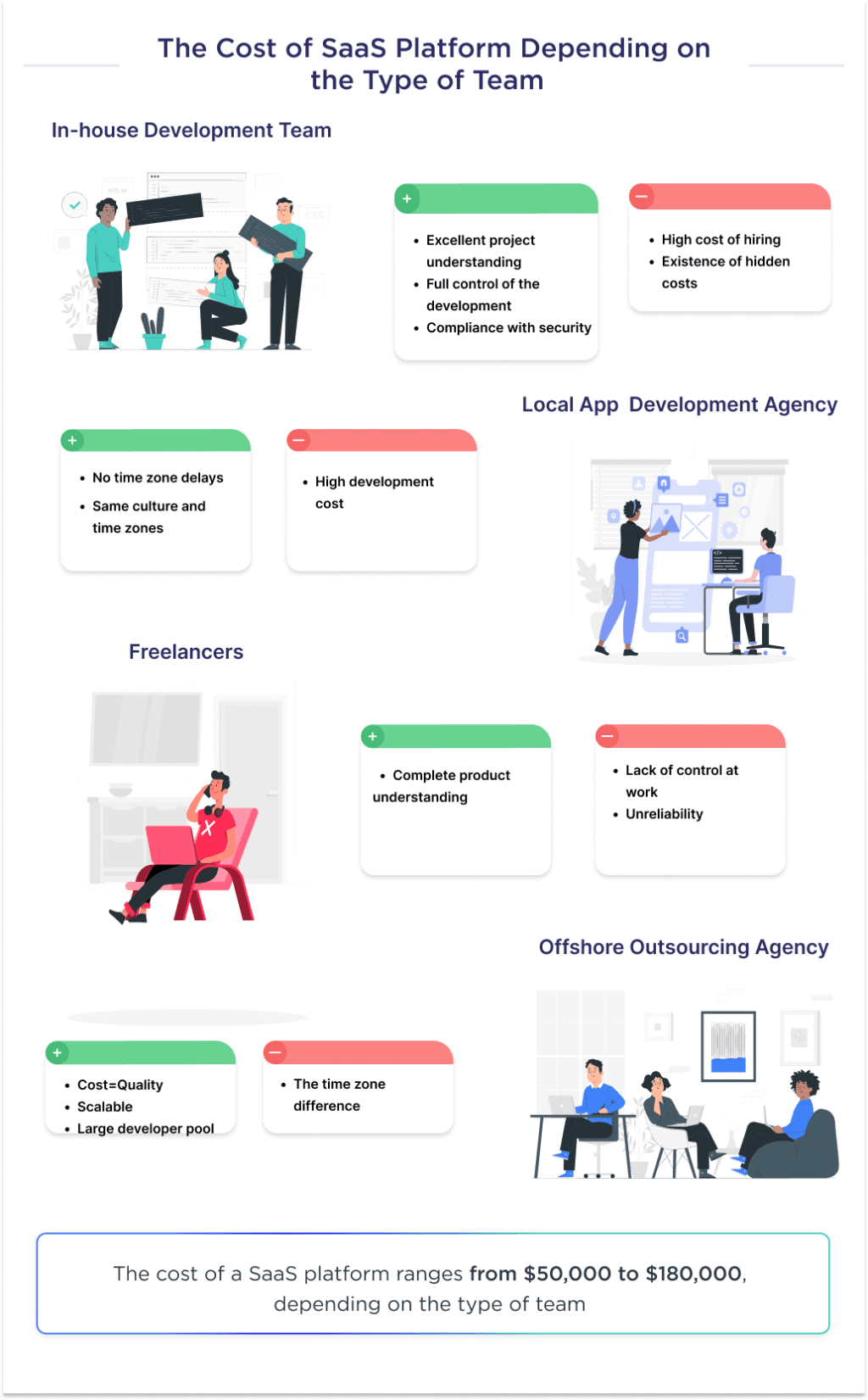
Need help building your SaaS product? Learn how to outsource SaaS development the right way.
Another cost-influencing factor for Software-as-a-Service projects is the team’s location.
Let’s delve into this a bit.
SaaS Development Cost Based on Location
The country where your team is domiciled is a huge factor in influencing the cost of Software-as-a-Service development.
For example, a typical SaaS business solution that costs $180,000 in the United States will cost $60,000 in Ukraine.
Below is a spreadsheet depicting the cost of developing your solution in some countries.
| Country | Average cost, $ |
| Australia | 120,000 |
| The USA | 180,000 |
| The UK | 150,000 |
| Western Europe | 100,000 |
| Eastern Europe | 70,000 |
| South Asia | 50,000 |
We analyzed the most significant factors in the SaaS development price.
Now, let’s look at some examples.
Development Cost Examples for 3 SaaS Companies
To better understand the cost of owning your Software-as-a-Service platform, we’ll use three examples as case studies.
Case Study 1: Slack Clone Cost
Slack is a communication platform where individuals can hold workplace-related conversations.
The core features of Slack
- In-app and email notifications
- Text, voice and video calls
- Channel privatization
- Apps integration (this feature helps it connect with other services )
- Instant messaging
- Reminders
- Messaging channels
The average cost of developing a SaaS messaging app would range between $70,000 and $100,000. The exact price depends on your SaaS design and the level of detail you want therein. 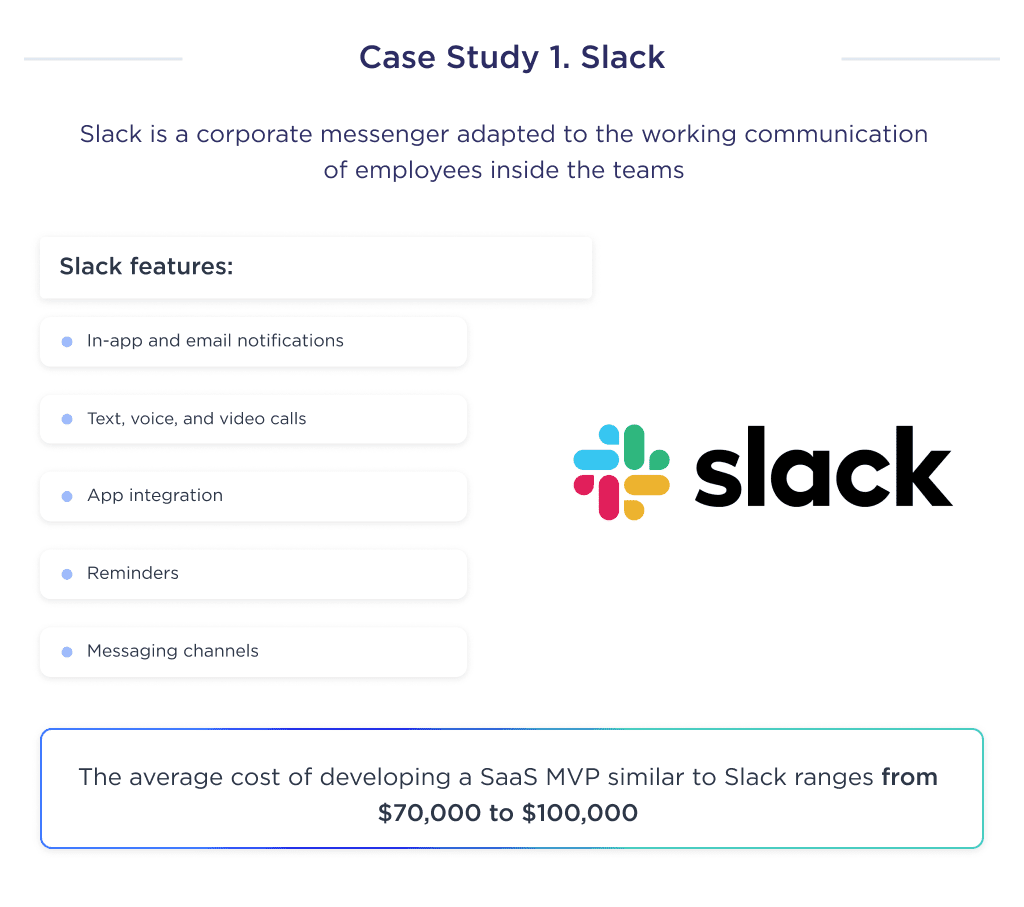
Case Study 2: MailChimp Clone Cost
Mailchimp is an all-encompassing marketing platform that aims to sharpen online marketing practices effectively.
The platform empowers millions of customers to start, grow, and market their businesses through the use of advanced marketing technology.
The key features of Mailchimp
- Custom forms
- RSS-to-Email
- Email automation
- A/B testing
- Geolocation
- Email pipelines
- Email segmentation
The development cost of such an MVP will be around $80,000 – $100,000. 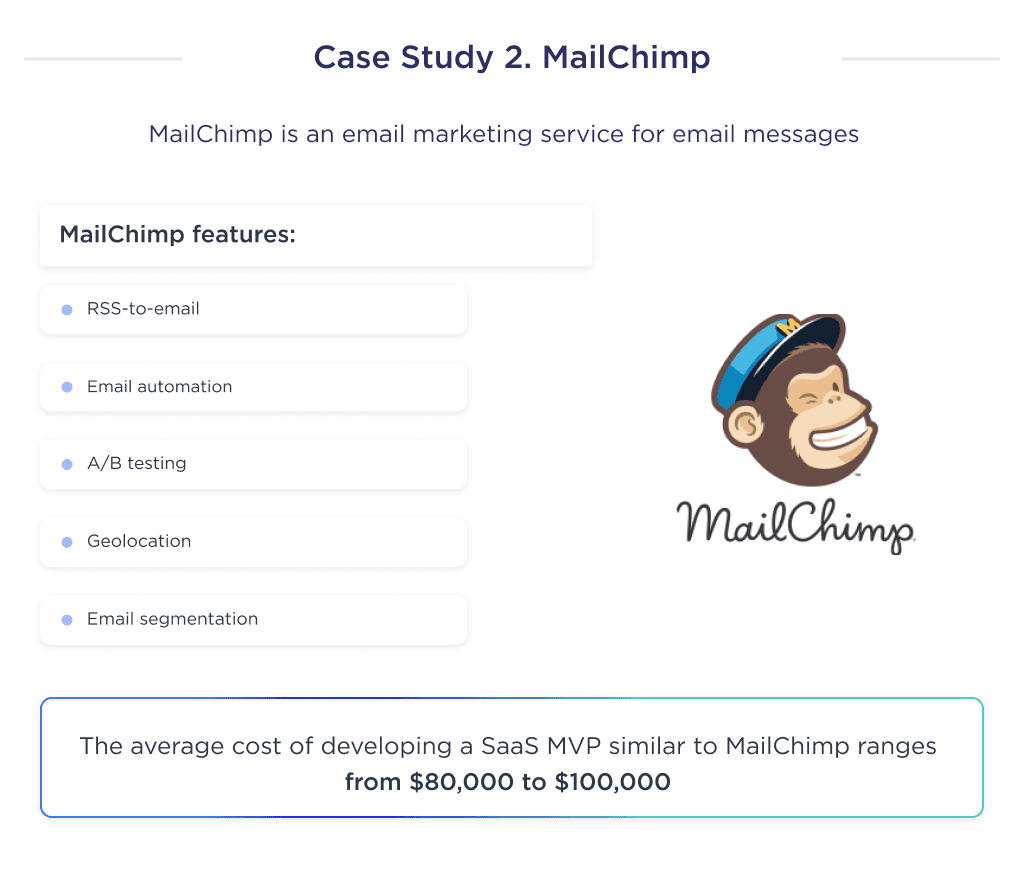
Case Study 3: Pipedrive Clone Cost
Pipedrive is a CRM platform tailored specifically to help users visualize their sales processes and maximize their leads.
Key Features of Pipedrive
- Salesforce automation
- Calendar
- Marketing automation
- Reporting & analytics
- Customer support
- Social media integration
As in the case study above, let’s imagine that you’d like to build a CRM from scratch. The cost of such an MVP will start at $60,000. 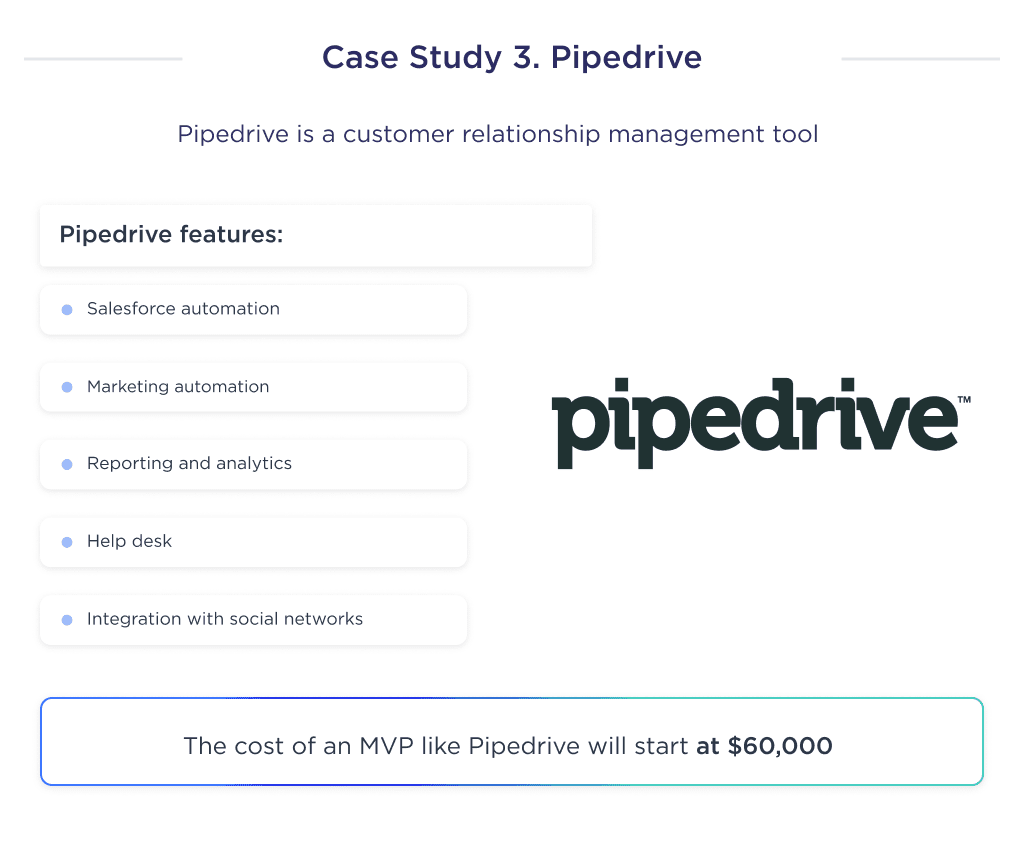
Want to build a SaaS product? This guide explains how to start a SaaS business step by step.
Now that you have an idea of the cost implication of developing a software-as-a-service let’s take a dig at some SaaS-specific cost-influencing factors.
Key Factors Influencing SaaS Dev Cost
Let’s discuss how software development teams calculate the cost of building a Software-as-a-Service application.
Supercharge your team with top IT talent.
1. Business Logic Complexity
The business logic is a compendium of the overall workings of the app, the purpose of creating the solution, and the outcomes users get from using the platform.
The business logic determines the following attributes:
- The complexity of the solution,
- The tech stack to use on frontend and backend,
- The number of external integrations,
- The number of team members,
- The size of the application, etc.
For example, you’d like to benefit from EHR software development services. If you decide to copy existing competitors, the development can cost up to $300,000. 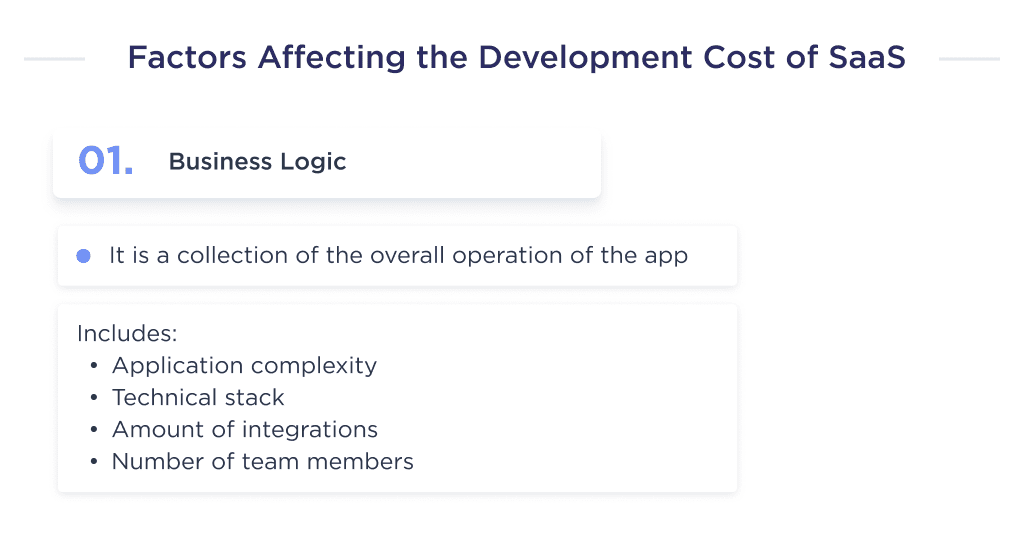
Let’s discuss another SaaS-specific cost influencing factor to note.
2. Tech Architecture
The technological architecture of a SaaS product entails the arrangement and interaction of entities according to the business and technical requirements.
Attributes within the technological architecture that determine the app development process and cost are:
- Number of API integrations,
- Multi-tenancy,
- Scalability, and more.
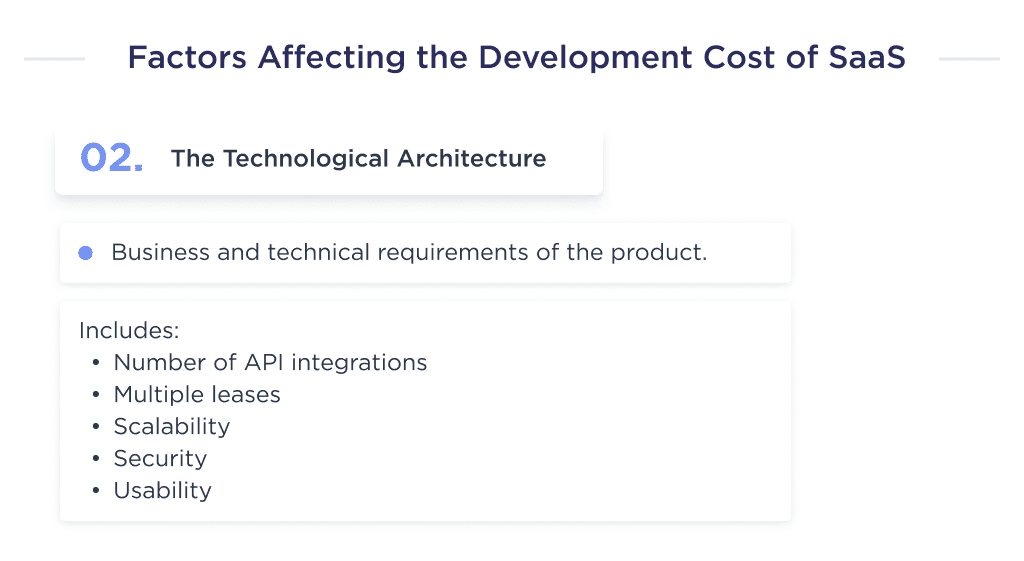
Another factor affecting the cost of developing software as a Service is the UX/UI design. Let’s discuss that in detail.
3. UX/UI Design
User Experience and User Interface design determine all actionable basic features, functionalities, and pages that the application will have.
Thus, it directly influences both the developmental activities and business logic involved in development.
A complex SaaS UX/UI design will make the design process more cumbersome for the front-end developer and increase the cost of building the app. 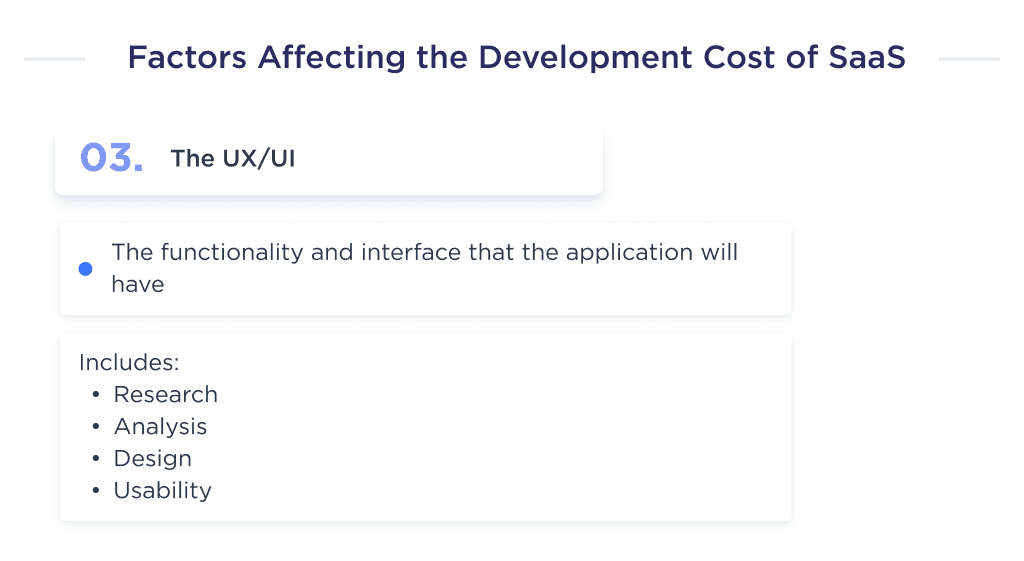
Now that you know the factors that affect the cost of developing a SaaS product, let’s discuss a bit of hidden costs that most founders and startups ignore.
Hidden Expenses of SaaS Development
These are costs that aren’t glaring to founders in the early face of the project.
The two more prominent SaaS product development hidden costs must be added to your total cost of ownership:
- Maintenance cost
- Marketing cost
Let’s discuss what each entails in detail.
1. Maintenance
Usually, support is about 25% of the software development cost. If the cost of developing your software-as-a-service is $100,000, then your maintenance cost can be as high as $25,000 per year.
Your maintenance cost will include spending on:
- Hosting
- Domain name
- SSL certificate
- Email services
- Premium technical support
This cost is necessary to keep your platform running and provide a quick fix if an error occurs.
Wondering how to choose the best hosting for your SaaS platform? This article on hosting for SaaS can help.
2. Marketing
Startup marketing is an important aspect of growing your user base and ensuring corporate goals are attained.
If your development cost is $100,000, then be ready to spend not less than $200,000 – $300,000 annually on marketing your product.
The annual cost of marketing is this high because of multiple financially demanding aspects that include:
- Information architecture,
- Technical, on-site, and off-site SEO,
- Email marketing,
- Product Hunt launches,
- PR and social media marketing, and more.
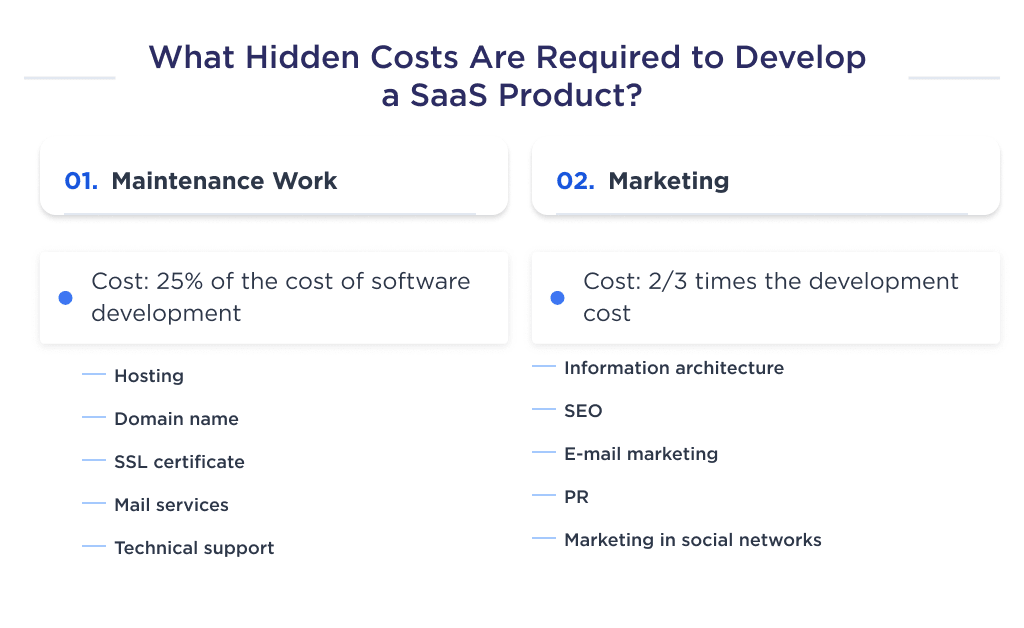
Now that you know the cost of creating a captivating and highly demanding Software-as-a-Service solution, let’s help you get started.
Want to Build Your Own SaaS?
There you have it – everything you need to know about the cost to develop your own SaaS platform.
As you saw, costs can vary widely based on features, team, and platform complexity. But with smart planning and an experienced development partner, you can launch an MVP for a reasonable budget.
If you want to turn your SaaS company idea into reality, the team at SpdLoad can help.
Our talented group of 70+ developers has over 10 years of expertise in building all types of digital solutions.
Want proof? Check out our portfolio and rave reviews on Clutch.
Contact us to schedule a free consultation and receive no-obligation estimates for design, development, and launch.
Here is a summary of our in-depth guide. Learn the basics about how much it costs to develop a SaaS application from scratch.
Bonus Infographics
Here is a summary of our in-depth guide. Learn the basics about how much it costs to develop a SaaS application from scratch.
Great SaaS design isn’t just about looks—it’s about solving problems. Learn how to design SaaS software that customers love. 













